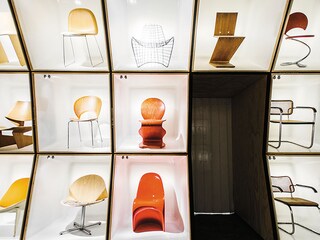What Denmark can teach us about sustainability
Denmark, long known for its design aesthetics, is using its expertise to integrate sustainability into everyday life


Pettersson’s efforts in the kitchen and in sustainable practices are a contemporary addition to the Danish design scene—it cuts across textile, food, furniture, industrial design, fashion, architecture and more—which has been part and parcel of Danish lives since the age of industrialisation. Iconic designers and architects, such as Hans Wegner, Arne Jacobsen and Kaare Klint are just a few of the many visionaries with creative and innovative minds who were instrumental in shaping the Danish design industry. But today, the Danes are using their design expertise to seamlessly integrate sustainability into every aspect of their lives.
“The good chair is a task one is never completely done with,” goes a quote by Hans Wegner. The chair, a piece of furniture with four legs and a seat, I assumed was the simplest of all. But at the Designmuseum Danmark in Copenhagen it was a revelation when I got to understand not just the science and complexity of chair designing, but also the many ways in which exemplary Danish designs have touched the lives of Danes.
“We usually say Danish design is about evolution, not revolution. By this we mean that Danish design stands on a long tradition of improving international and historical furniture. Instead of erasing history, it builds on previous prototypes,” says Anne-Louis Sommer, museum director and adjunct professor at University of Southern Denmark. “The so-called Klint-school had a big influence on what we call Danish design today. The idea was to take something good and make it better. Refining pre-existing furniture types, always with an eye for functionality and human needs.”
“Danish aesthetics since the modern times are much simpler, and not as labour-intensive,” says award winning ceramist Inge Vincents, the maker of beautiful yet simple vases, mugs and bowls of translucent porcelain. “Craftsmen in the olden days were very well paid and you could work on ornamental pieces and they wouldn’t be that expensive. That’s not possible today. If I spend two weeks decorating a pot and I must pay rent and everything, nobody would be able to afford that pot. So Danish aesthetics are quite simple. It balances functionalism and beauty.”
Vincents’ studio is located on Jaegersborggade, a gentrified street in the Nørrebro neighbourhood of Copenhagen. Her kiln is powered by wind energy and is thus sustainable. About 10 years ago, Jaegersborggade used to be a dodgy street that was avoided by locals and dominated by drug peddlers. But today it is a multicultural residential area with artisan shops and restaurants.
*****
Meik Wiking, CEO of the Happiness Research Institute, writes in his book The Little book of Hygge: “Danes are aware of the decoupling of wealth and wellbeing. After our basic needs are met, more money doesn’t lead to more happiness.”
Denmark’s welfare model is designed around the wellbeing of its citizens. Their working hours are restricted to 37 and a half hours a week, contributing towards a better work-life balance. While they pay high taxes, they receive social security, free education, universal health care and a universal pension.
Good food, coffee and confectionary are other factors attributed to hygge. “Cakes are part of Danish culture and hygge gets better with cake and coffee. Here we serve coffee by the pot, and you cannot share it,” says Marianne Stagetorn Kolos, owner of the 149-year-old ever-busy confectionary La Glace in Copenhagen. “The idea is for you to sit, relax and enjoy.”
“Design plays a major role in our lives. We invest time and money to set up cosy homes. Everything is thought through—the lamp in the corner, the rugs, the pillows on the couch. It’s a big thing for us,” says Ditte Nytofte, my host in Copenhagen. “We save money to buy good quality things, like the hand-painted porcelain products of Royal Copenhagen, which was founded in 1775. Second-hand products are also sold and bought by Danes through the DBA app.”
The significance of design finds reflection even in the country’s transport and travel infrastructure. For instance, in Copenhagen, where 45 percent of residents cycle to school and work—parents ferry their children in cargo bikes—the city’s infrastructure includes cycle tracks that are clearly segregated by curbs. The Cycling Embassy of Denmark also works with cities across the world to design cycle-friendly spaces and develop cycling infrastructure, reducing congestion and pollution.
*****
The concept of recycling and repurposing extends well beyond products and encompass entire spaces for living and recreation. Take, for example, the transformed industrial peninsula of Refshaleøen, where I spot a chimney puffing out white smoke. This is the iconic, decade-in-the-making waste-to-energy plant called CopenHill, which was recently opened to the public. Built by the Bjarke-Ingels Group, a global network of architects, designers, urbanists, landscape professionals, interior and product designers, researchers and inventors, the plant is capable of converting 440,000 tonnes of waste into clean energy in a year. Pollutants and particles are filtered out before the gas is released from its chimney. The power plant’s roof houses an artificial ski slope, hiking trails and the world’s tallest climbing wall.
Denmark’s approach to design is evident in everyday architecture, such as the Cirkelbroen Bridge, a pedestrian bridge spanning the southern mouth of Christianshavn Canal, and designed by Olafur Eliasson. With five circular platforms and wire masts that resemble a ship’s rigging, it is meant for people to pause and reflect.
As I walk towards Tivoli Gardens, the world’s second-oldest operational amusement park that opened in 1843, and the inspiration for Walt Disney’s Disneyland, I wonder how seriously the Danes must take their fun moments. No surprise then that the world’s oldest operational amusement park—called Dyrehavsbakken, it opened in 1583—is also in Denmark, in nearby Klampenborg. My hygge moments with Denmark continue.
The writer was in Denmark on the invitation of Wonderful Copenhagen
First Published: Dec 07, 2019, 07:20
Subscribe Now